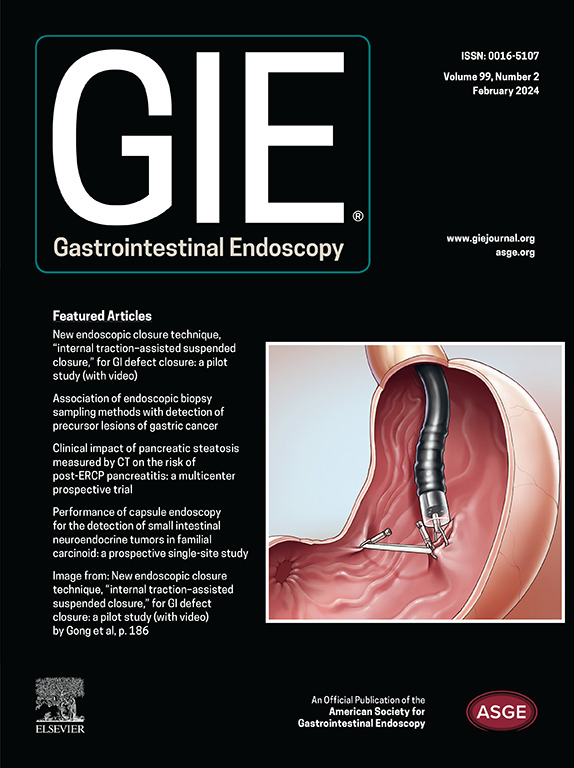内镜超声剪切波弹性成像用于肥胖和代谢功能障碍相关性脂肪肝(MASLD)患者的纤维化筛查:一项试点研究(附视频)。
IF 6.7
1区 医学
Q1 GASTROENTEROLOGY & HEPATOLOGY
引用次数: 0
摘要
背景和目的:对肥胖和代谢功能障碍相关性脂肪性肝病(MASLD)患者进行肝纤维化分期具有挑战性。肝活检是侵入性的,而振动控制瞬态弹性成像(VCTE)等非侵入性检测在肥胖症患者中可能不准确。我们假设内镜超声剪切波弹性成像(EUS-SWE)对肥胖症患者的肝纤维化分期更为准确,本试验研究旨在验证这一假设,并为 EUS-SWE 确定最佳纤维化分期临界值:这是一项根据前瞻性收集的数据进行的多中心横断面研究。研究纳入了接受 EUS-SWE 检查并随后进行肝活检的连续患者。EUS-SWE 与纤维化-4 指数(FIB-4)和 VCTE 进行了比较。进行了接收者操作特征曲线下面积(AUROC)分析,并计算了90%的灵敏度和特异性临界值,以确定最佳临界值:结果:共纳入 62 名患者。平均体重指数为 40.74kg/m2。EUS-SWE 在鉴别明显纤维化方面优于 FIB-4(F2;AUROC 0.87 vs 0.61,pConclusions):在这项试验性研究中,EUS-SWE在对肥胖症MASLD患者的肝纤维化分期方面优于FIB-4和VCTE(临床试验注册号:NCT05728697)。本文章由计算机程序翻译,如有差异,请以英文原文为准。
EUS-guided shear wave elastography for fibrosis screening in patients with obesity and metabolic dysfunction–associated steatotic liver disease: a pilot study (with video)
Background and Aims
Liver fibrosis staging is challenging in patients with obesity and metabolic dysfunction–associated steatotic liver disease (MASLD). Liver biopsies are invasive, whereas noninvasive tests such as vibration-controlled transient elastography (VCTE) can be inaccurate in patients with obesity. We hypothesized that EUS-guided shear wave elastography (EUS-SWE) is more accurate for liver fibrosis staging in patients with MASLD and obesity; the aim of this pilot study was to test this hypothesis and establish optimal fibrosis stage cutoffs for EUS-SWE.
Methods
This was a multicenter, cross-sectional study from prospectively collected data. Consecutive patients who underwent EUS-SWE with subsequent liver biopsy were included. EUS-SWE was compared with Fibrosis-4 Index (FIB-4) and VCTE. Area under the receiver-operating characteristic (AUROC) curve analysis was performed, and 90% sensitivity and specific cutoffs were calculated to determine optimal cutoffs.
Results
Sixty-two patients were included. Mean body mass index was 40.74 kg/m2. EUS-SWE was superior to FIB-4 in discriminating significant fibrosis (F2; AUROC, .87 vs .61; P < .0048) and advanced fibrosis (F3; AUROC, .93 vs .63; P < .0001), but not cirrhosis (F4; AUROC, .95 vs .81; P = .099). EUS-SWE was superior to VCTE in predicting advanced fibrosis and cirrhosis (P = .0067 and P = .0022, respectively). The 90% sensitivity cutoffs for EUS-SWE were 7.50, 8.48, and 11.30 for F2, F3, and F4, and the 90% specificity cutoffs were 9.82, 10.20, and 14.60.
Conclusions
In this pilot study, EUS-SWE was superior to FIB-4 and VCTE for liver fibrosis staging in patients with MASLD and obesity. (Clinical trial registration number: NCT05728697.)
求助全文
通过发布文献求助,成功后即可免费获取论文全文。
去求助
来源期刊

Gastrointestinal endoscopy
医学-胃肠肝病学
CiteScore
10.30
自引率
7.80%
发文量
1441
审稿时长
38 days
期刊介绍:
Gastrointestinal Endoscopy is a journal publishing original, peer-reviewed articles on endoscopic procedures for studying, diagnosing, and treating digestive diseases. It covers outcomes research, prospective studies, and controlled trials of new endoscopic instruments and treatment methods. The online features include full-text articles, video and audio clips, and MEDLINE links. The journal serves as an international forum for the latest developments in the specialty, offering challenging reports from authorities worldwide. It also publishes abstracts of significant articles from other clinical publications, accompanied by expert commentaries.
 求助内容:
求助内容: 应助结果提醒方式:
应助结果提醒方式:


